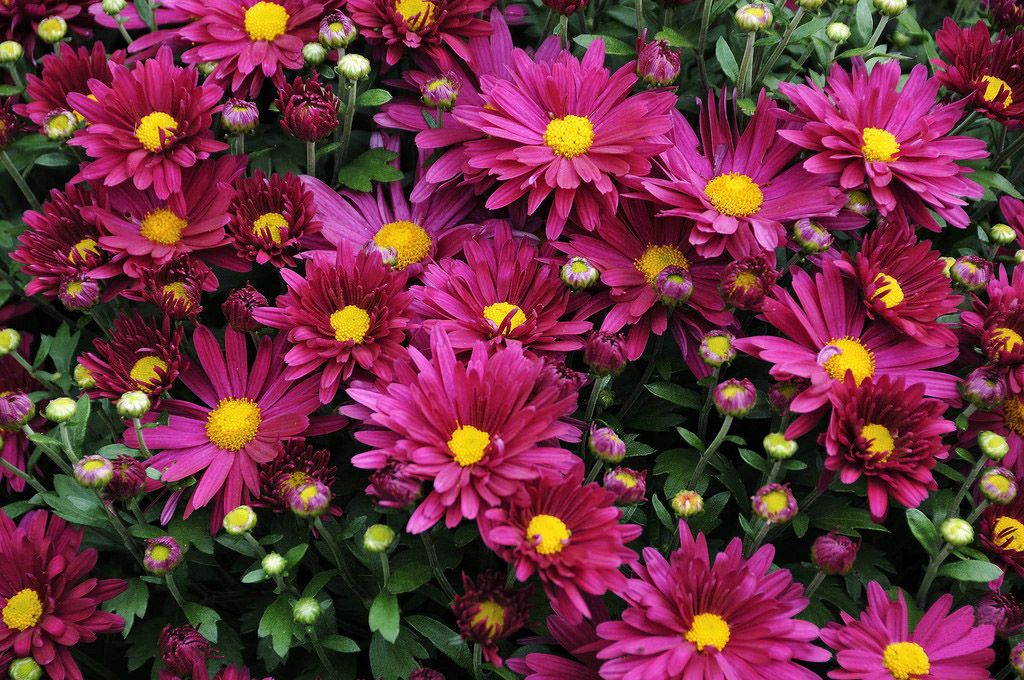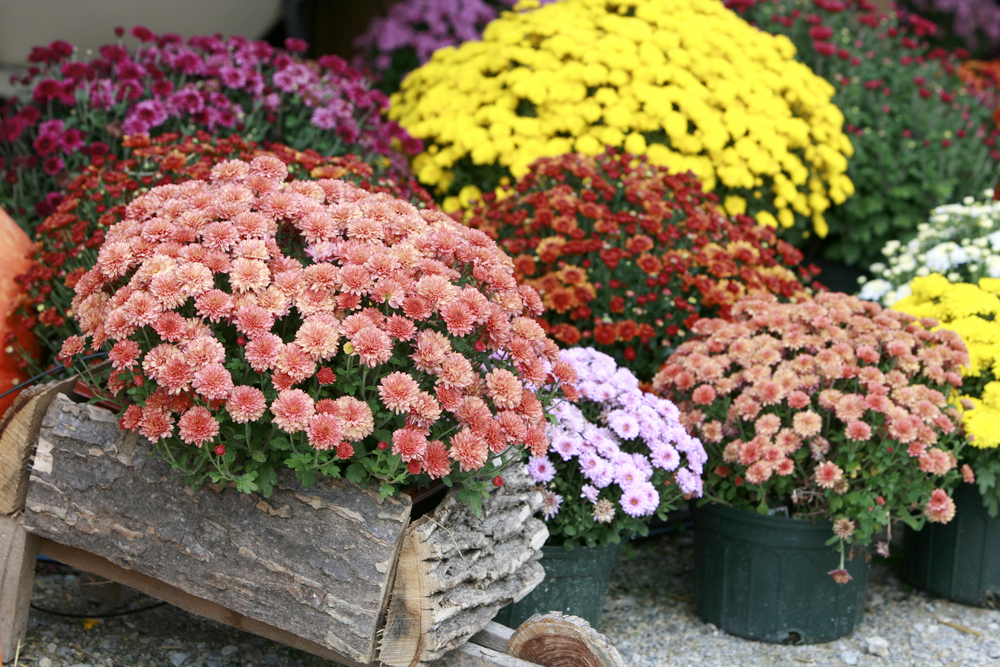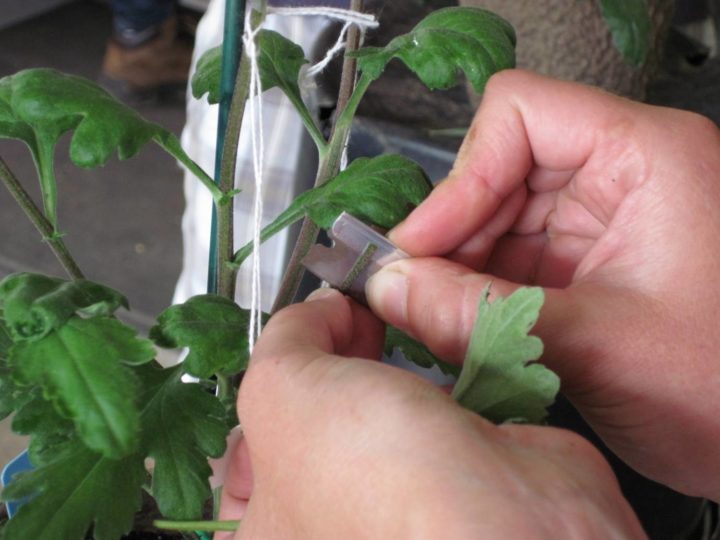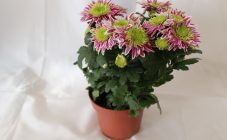Content:
Garden chrysanthemum is considered a real decoration of any landscape, it looks especially impressive and colorful against the background of an autumn landscape. Many amateur flower growers prefer this particular autumn flower, since it is not afraid of the cold, it blooms beautifully and profusely. In addition to decorating flower beds and flower beds, chrysanthemums can be used to make a gorgeous bouquet that does not fade for a long time and retains freshness. In addition, chrysanthemum is not only an ornamental crop - many of its varieties also have medicinal properties. The petals contain a lot of potassium, zinc, magnesium, selenium, which are so necessary for the maintenance and treatment of the human body. So, flowers and leaves are used for gastrointestinal and eye diseases, sleep disorders, and nervous system disorders.
A bit of history
The plant has a different name for a reason - mulberry, or Chinese chrysanthemum. Many historians consider China to be the birthplace of culture, where for the first time the philosopher Confucius, who lived in 479-551 BC, mentioned in his works the chrysanthemum as an ornamental plant. Then, according to the external description, small-flowered yellow chrysanthemums looked more like a wild plant. But over time, thanks to the efforts of Chinese flower growers, many different varieties have appeared (currently there are about 3000 species), which fascinate with the bizarre shapes and shades of their inflorescences.
A little later, chrysanthemum began to be grown in Japan, where it is currently the most beloved and revered flower among the inhabitants of the country.
Chrysanthemum was brought to Europe, namely to France, in 1789, the plant first came to England only in 1846, then the plant began to be cultivated in America and Canada.
Botanical description
Depending on the length of the life cycle, chrysanthemums are annual and perennial, herbaceous and semi-shrub. Among them, the most common perennial species in floriculture have the following botanical description:
- The root is branched and forms stolon-like underground shoots;
- The stem is erect, 25 to 120 cm high, in some varieties it is highly branched, forming a lush bush. Thin branches are abundantly leafy.
- Leaves are petiolate, arranged alternately on the stem. The size of the leaves depends on the type of chrysanthemum: in small-flowered species, their length is 7 cm, width - 4 cm, in large-flowered species, the length reaches 15 cm, width - 8 cm.The shape and degree of dissection of the leaf plate depends, first of all, on the variety. The upper side of the leaf is green, the lower surface of the leaves is heavily pubescent, which is why it has a pale green color.
- The inflorescence is a basket, consisting of a large number of reed and tubular flowers. Reed are located along the edges of the basket, the middle of the inflorescence is formed by tubular flowers. The size of the inflorescences depends on the variety of chrysanthemums: in small-flowered species, the diameter of the basket can be from 4 cm to 9 cm, in large-flowered and double chrysanthemums - from 10 cm to 20 cm. The inflorescences can be painted as in standard white, gold, red. There are also such beautiful in color chrysanthemum inflorescences, such as orange, lilac. The largest and most lush single inflorescences are the so-called single-headed chrysanthemums.
- The fruit is a simple achene.
Inflorescences of chrysanthemums of various varieties and species are very diverse in their shape. So, for example, if a marsh type of chrysanthemum (its typical representative is a marsh chrysanthemum, or daisy) has simple inflorescences similar to chamomile flowers, then many varieties of large-flowered chrysanthemums have a double needle-like type of inflorescence formed by small simple middle and marginal flowers with elongated thin petals ...
Characteristics of crop species
Depending on the size of the inflorescences, perennial chrysanthemums are of two types:
- Small-flowered - frost-resistant and unpretentious type of this culture with a small-diameter inflorescence. With proper pruning and shelter, it winters well. It is grown as a perennial crop in a temperate climate in flower gardens and flower beds, in single plantings;
- Large-flowered (Indian) is a thermophilic and demanding species for growing conditions. It differs from the previous one in large inflorescences, low frost resistance. It is grown in southern regions with a mild climate, in greenhouses, greenhouses, winter gardens. It can also be grown outdoors in the northern regions of Russia. Then, so that the plant does not freeze in winter, it is dug up in the fall and placed in a cool basement or cellar.
A separate variety of garden chrysanthemum can be distinguished by such characteristic features as:
- Flowering time;
- Bush height;
- The size and color of the inflorescences;
- Terry degree;
- Petal shape;
- Frost resistance.
For example, the "Malchish-Kibalchish" border chrysanthemum grows up to 30 cm high and has an inflorescence in the form of a single pink basket. The Ruby Stars variety, on the contrary, has a bush of 80 cm and a double red inflorescence. Also, among the varietal diversity among amateur flower growers, such a Dutch variety as "Anastasia" is especially popular, which is a medium-sized plant, 60-70 cm high, with beautiful and large snow-white inflorescences.
Landing
Site selection
Being a warm - and a light-loving plant, chrysanthemum grows best on sunny buildings, sheltered from drafts and cold winds, and fences.This culture also does not like excessive moisture of the root system, therefore, for planting it, you should choose high places with deep groundwater. Chrysanthemum also grows poorly on acidic peat bogs, heavy clay soils, low-fertile sands with high cultivation capacity.
Landing
The planting process itself consists of such operations as:
- In the selected place, a round planting hole is dug, 30-40 cm deep and in diameter;
- The bottom of the pit is drained (increasing its moisture permeability and reducing the risk of waterlogging of the roots) using a layer of coarse sand or fine gravel placed in it;
- A small mound of fertile land is poured at the bottom of the hole in the center;
- The seedling is placed in a hole in such a way that each of its small straightened roots rests on the surface of the mound;
- Holding the seedling in this position, the roots are carefully sprinkled with fertile soil, carefully compacting each layer for better contact of the plant root system with the soil;
- Tall seedlings, when planting, are tied to a support inserted into the bottom of the planting hole;
- After filling the root system of the seedling, it is watered, the soil near the plant is mulched with peat, humus;
- The aerial part of the seedling is shortened by 1/3 or completely cut off at the very surface of the soil. Such pruning during planting accelerates plant survival and reduces moisture evaporation through the leaves.
Also, to obtain flowers for sale, perennial bush undersized chrysanthemums are grown in winter greenhouses. This makes decorative chrysanthemums not only a decoration for a flower bed, flower garden and window sill, but also an object of commercial floriculture. The lush and beautiful single-headed chrysanthemum with spherical volumetric flowers is especially appreciated in bouquets and flower arrangements. In amateur floriculture, along with a tall bush species, the curb stunted one is very common, represented by a large number of ground cover and low-growing abundantly flowering varieties with beautiful inflorescences of various shapes, sizes, colors.
Care
Watering
Chrysanthemum, a moisture-loving crop, requires frequent and abundant watering. During the growing season, plantings of chrysanthemums are watered according to the following scheme:
- Spring - maintenance periodic watering of chrysanthemums is carried out if the spring was dry, and after the snow melted, little moisture was formed;
- Midsummer (June-July) - during the budding phase, the chrysanthemum is abundantly watered at the root with warm settled rainwater. The average watering rate for 1 plant is 4-5 liters;
- Late summer-early autumn (August-September) - as the plant begins to bloom, watering is reduced to 2-3 liters;
- Autumn - water chrysanthemum bushes only when autumn is dry and warm enough. If autumn is cold and rainy, no watering is done.
Topping
Pinching is the removal of the top of the plant in order to enhance the growth of side shoots. This operation allows you to make the bush lush and spreading.
The pinching technology depends on the species of the chrysanthemum:
- In large-flowered varieties, only single shoots are left, the rest are pinched (removed).
- In small-flowered varieties, pinch the tops so that new shoots form in the axils, which will make the bush more spreading and lush
Top dressing
During the warm season, plantings of chrysanthemums are fed 3 times:
- The first feeding is done in early April, as the buds awaken. Chrysanthemum is fed by watering it under the root with a solution of nitrogen fertilizers (17 g of ammonium nitrate per 12 liters of water) or infusion of mullein diluted with water in a ratio of 1:10.
- In the budding phase (June-July), plants are fed for abundant and more friendly flowering with nitrophos at a dose of 20 g per plant (2 tablespoons);
- Autumn feeding is carried out with phosphorus and potassium fertilizers at a dose of 15 g of superphosphate and 20 g of potassium sulfate per plant. Tukas are evenly scattered over the soil surface near the plant and sealed when loosening.
Loosening and mulching
Loose the surface of the soil near the chrysanthemum every 10-12 days. Mulch the soil in early spring and autumn before sheltering the plants for the winter. Peat, humus, rotted manure are used as mulch.
Shelter for the winter
Reproduction
The garden chrysanthemum is bred in several ways: by sowing seeds, cuttings or dividing the bush. Let's take a quick look at each of them.
The first method of growing chrysanthemums by flower growers is used relatively rarely for the following reasons:
- It takes a lot of time for the seeds to fully ripen, so the plants that are planned to be used for collecting seed have to be planted early;
- You can independently prepare the seeds of small-flowered chrysanthemums, in large-flowered varieties the seeds are tied weakly and ripen poorly;
- A seedling grown from its own seed material most often does not retain the main decorative features of the original variety, its inflorescences lose their doubleness and become smaller in size.
For growing seedlings, small boxes are taken, up to 6-8 cm in height, they are filled with a soil mixture of an equal amount of humus, high peat and fertile soil. Also, ready-made primer can be purchased at a specialized store. The seeds are covered with a layer of 7-9 mm of sifted river sand, moistened and covered with a film. At an air temperature of 15-18 ° C, the first shoots appear on the 10-12th day. But this is not the most efficient way to grow a perennial. It is much easier to plant perennial garden chrysanthemums in a vegetative way, i.e. by cuttings or dividing the bush.
During the flowering period, a plant is chosen for grafting, the bush should be sufficiently branched, abundantly flowering, without signs of any diseases. When the chrysanthemum completely fades, its aerial part is cut off, the plant itself is transplanted into a pot and placed in a room where the air temperature is 8-10 ° C.
A month before grafting, the plant is placed in a warmer place (10-14 ° C) and watered. As soon as young shoots appear, and 6-7 true leaves are formed on them, they begin to cuttings. Cuttings 6-8 cm long are planted in sand to a depth of 1.5-2.0 cm. In order for the cuttings to take root faster, the temperature in the room is maintained at 15-17 ° C. When the top begins to grow, the plant is ready for planting in open ground.
Diseases and pests
The main diseases of garden chrysanthemum are:
- Rust;
- Septoria (leaf spot);
- Powdery mildew;
- Fusarium wilting;
- Viral mosaic.
Among the pests, the most dangerous are:
- Spider mite;
- Aphid;
- Leaf nematode.
For their extermination, damaged plants are sprayed with such insecticides as Iskra, Imidor, Fitoverm, and Topaz.
Before giving a beautiful colored bouquet, you need to choose the right one in order to give the ceremony a certain meaning. So, burgundy and red chrysanthemums symbolize love, affection, passion, therefore they are presented to the most dear and beloved people. If the bouquet contains blue or purple chrysanthemums, then it will suit close friends and relatives as a sign of respect.

















